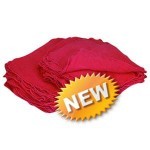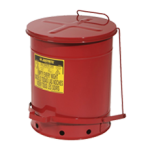Way back in July 23, 2013 the Environmental Protection Agency (EPA) announced an impending – and long awaited – modification of the nation’s hazardous waste regulations to conditionally exclude certain solvent-contaminated wipes from specific hazardous waste requirements. This long-awaited final rule makes the following changes to the EPA’s hazardous waste regulations:

- Creates the following new terms and definitions at 40 CFR 260.10:
- No free liquids
- Solvent-contaminated wipes
- Wipe
- Creates a new conditional exclusion from definition as a solid waste at 40 CFR 261.4(a)(26): Solvent-Contaminated Wipes Sent for Cleaning and Reuse
- Creates a new conditional exclusion from definition as a hazardous waste at 40 CFR 261.4(b)(18): Solvent-Contaminated Wipes, Except Wipes with Trichloroethylene, Sent for Disposal.
These new Federal regulations went into effect on January 31, 2014. However, since they represent a relaxation and reduction of existing EPA regulations they are not effective in states with an authorized hazardous waste program unless and until that state chooses to adopt them. Among the states with an authorized hazaroud waste program, some have chosen to adopt the Federal rule as their own, some are in consideration, and others have indicated an intention not to adopt it, but what about Iowa?

Iowa does not have an authorized hazardous waste program under RCRA and, according to an informal conversation with an IDNR official, it has no intention of ever acquiring one. Therefore this Federal rule is effective in Iowa as of January 31st 2014 and a person or business in Iowa has the option to follow this conditional exclusion for the management of its solvent-contaminated wipes. Please carefully review the requirements of this conditional exclusion to determine your compliance with these Federal regulations.
First we’ll start with the new definitions in §260.10:
No free liquids, as used in 40 CFR 261.4(a)(26) and 40 CFR 261.4(b)(18), means that solvent-contaminated wipes may not contain free liquids as determined by Method 9095B (Paint Filter Liquids Test), included in “Test Methods for Evaluating Solid Waste, Physical/Chemical Methods” (EPA Publication SW-846), which is incorporated by reference, and that there is no free liquid in the container holding wipes. No free liquids may also be determined using another standard or test method as defined by an authorized state.
Solvent-contaminated wipe means a wipe that, after use or after cleaning up a spill, either (1) contains one or more of the F001 through F005 solvents listed in 40 CFR 261.31 or the corresponding P- or U- listed solvents found in 40 CFR 261.33; (2) exhibits a hazardous characteristic found in 40 CFR part 261 subpart C when that characteristic results from a solvent listed in 40 CFR part 261; and/or (3) exhibits only the hazardous waste characteristic of ignitability found in 40 CFR 261.21 due to the presence of one or more solvents that are not listed in 40 CFR part 261. Solvent-contaminated wipes that contain listed hazardous waste other than solvents, or exhibit the characteristic of toxicity, corrosivity, or reactivity due to contaminants other than solvents, are not eligible for the exclusions at 40 CFR 261.4(a)(26) and 40 CFR 261.4(b)(18).
Wipe means a woven or non-woven shop towel, rag, pad, or swab made of wood pulp, fabric, cotton, polyester blends, or other material.
The definition of No Free Liquids may mistakenly lead you to believe that any free liquids in a solvent-contaminated wipes container precludes the use of this exclusion; this is not so. The issue of free liquids in the solvent-contaminated wipes container will be addressed later in this article.
Like this article? Subscribe to my Monthly Newsletter No marketing emails! |
To meet the definition and be subject to the exclusion a solvent-contaminated wipe must be either of the following:
- Cleaned and reused after use at an industrial laundry or dry cleaner (hereafter referred to as “reusable wipes”).
Or…
- Disposed of after use at a municipal solid waste landfill or a solid waste combustion unit (hereafter referred to as “disposable wipes”).
In addition, a solvent contaminated wipe must be one of the following:
- A wipe containing one or more F001-F005 listed solvents found in §261.31 or the corresponding P- or U-listed solvents found in §261.33, including those listed in Table 1:
Table 1 – Listed Solvents (from 40 CFR 261) for the Solvent-Contaminated Wipes Conditional Exclusion
Acetone | Isobutyl Alcohol | Benzene |
Methanol | n-Butanol | Methyl Ethyl Ketone |
Chlorobenzene | Methyl Isobutyl Ketone | Creosols |
Methylene Chloride | Cyclohexanone | Tetrachloroethylene |
1,2-Dichlorobenzene | Toluene | Ethyl Acetate |
1,1,2-Trichloroethane | Ethyl Benzene | Trichloroethylene (for reusable wipes only) |
2-Ethoxyethanol | Xylenes |
Or…
- A wipe that exhibits a hazardous waste characteristic (Ignitability, Corrosivity, Reactivity, or Toxicity) resulting from a solvent listed in Table 1.
Or…
- A wipe that exhibits only the hazardous characteristic of Ignitability resulting from a solvent not listed in §261 or Table 1.
Question: What is an example of a solvent that exhibits only the hazardous characteristic of Ignitability from a solvent not listed in §261? Answer: Isopropyl Alcohol (aka Isopropanol) is just one example. |
Whether reusable or disposable, a solvent-contaminated wipe must be managed according to specific requirements in order be subject to the exclusion, these include:

- On-site accumulation and off-site transportation must be in closed containers (sealed for off-site transportation) that are capable of containing free liquids, if any are present.
- Containers must be labeled: “Excluded Solvent-Contaminated Wipes”.
- On-site accumulation of solvent-contaminated wipes may not exceed 180 days.
- Containers of solvent-contaminated wipes may not contain free liquids at the point of being sent off-site. If present, any free liquids removed from the wipes during its on-site accumulation will need to be managed as a hazardous waste. Free liquids may be present in a solvent-contaminated wipes container for the 180 days that it remains on-site and need not be managed as a distinct wastestream until the point the wipes are shipped off-site for disposal or laundering.
- Generators of solvent-contaminated wipes must maintain records of documents that include:
- Name and address of the laundry, dry cleaner, landfill, or combustion unit.
- Evidence that the 180 day on-site accumulation limit has not been exceeded. This can be accomplished by placing the initial date of accumulation on the container.
- Description of the process the generator is using to meet the “no free liquids” condition.
- As noted above, the presence of free liquids in the solvent-contaminated wipes container is not a violation of the regulations. However, the free liquids, if present, must be managed properly when the solvent-contaminated wipes are shipped off-site. To determine if free liquids are present, refer to the definition in §260.10, it references the EPA standard method to identify the presence of free liquids: the Paint Filter Test.
- A reusable wipe, if excluded from definition as a solid waste at 40 CFR 261.4(a)(26) is neither a solid waste nor a hazardous waste and is therefore not subject to any regulation in Iowa other than the requirements of the exclusion itself.
- A disposable wipe, if excluded from definition as a hazardous waste at 40 CFR 261.4(b)(18), remains a solid waste and may be an Iowa Special Waste. In Iowa, generators of Special Waste must receive approval from a landfill prior to disposal (see: Special Waste Authorization in Iowa).
- Disposable wipes that are contaminated with Trichloroethylene are not eligible for the exclusion. EPA feels wipes contaminated with Trichloroethylene are not safe for disposal in a municipal solid waste landfill. Therefore, these disposable wipes will need to be managed as a hazardous waste.
- Reusable wipes must go to a laundry or dry cleaner whose wastewater discharge, if any, is regulated under the Clean Water Act. Disposable wipes must go to one of the following:
- A combustor regulated under the Clean Air Act.
- A hazardous waste combustor, boiler, or industrial furnace regulated under RCRA.
- A municipal solid waste landfill or hazardous waste landfill regulated under RCRA.
Daniels Training Services 815.821.1550/Info@DanielsTraining.com/https://danielstraining.com/ |
Much more information about the Solvent Wipe Rule can be found at the following sources:
- Solvent-Contaminated Wipes Rulemaking FAQ’s
- Solvent-Contaminated Wipes Management Summary Chart
- Pre-Publication Version of the Signed Final Rule
Please don’t hesitate to contact me with any questions about the Solvent Wipe Rule or the management of hazardous waste in Iowa.
